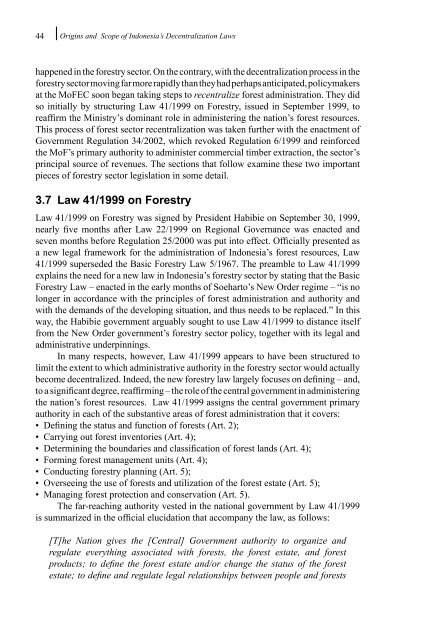Decentralization of Forest Administration in Indonesia, Implications ...
Decentralization of Forest Administration in Indonesia, Implications ...
Decentralization of Forest Administration in Indonesia, Implications ...
You also want an ePaper? Increase the reach of your titles
YUMPU automatically turns print PDFs into web optimized ePapers that Google loves.
44<br />
Orig<strong>in</strong>s and Scope <strong>of</strong> <strong>Indonesia</strong>’s <strong>Decentralization</strong> Laws<br />
happened <strong>in</strong> the forestry sector. On the contrary, with the decentralization process <strong>in</strong> the<br />
forestry sector mov<strong>in</strong>g far more rapidly than they had perhaps anticipated, policymakers<br />
at the MoFEC soon began tak<strong>in</strong>g steps to recentralize forest adm<strong>in</strong>istration. They did<br />
so <strong>in</strong>itially by structur<strong>in</strong>g Law 41/1999 on <strong>Forest</strong>ry, issued <strong>in</strong> September 1999, to<br />
reaffirm the M<strong>in</strong>istry’s dom<strong>in</strong>ant role <strong>in</strong> adm<strong>in</strong>ister<strong>in</strong>g the nation’s forest resources.<br />
This process <strong>of</strong> forest sector recentralization was taken further with the enactment <strong>of</strong><br />
Government Regulation 34/2002, which revoked Regulation 6/1999 and re<strong>in</strong>forced<br />
the MoF’s primary authority to adm<strong>in</strong>ister commercial timber extraction, the sector’s<br />
pr<strong>in</strong>cipal source <strong>of</strong> revenues. The sections that follow exam<strong>in</strong>e these two important<br />
pieces <strong>of</strong> forestry sector legislation <strong>in</strong> some detail.<br />
3.7 Law 41/1999 on <strong>Forest</strong>ry<br />
Law 41/1999 on <strong>Forest</strong>ry was signed by President Habibie on September 30, 1999,<br />
nearly five months after Law 22/1999 on Regional Governance was enacted and<br />
seven months before Regulation 25/2000 was put <strong>in</strong>to effect. Officially presented as<br />
a new legal framework for the adm<strong>in</strong>istration <strong>of</strong> <strong>Indonesia</strong>’s forest resources, Law<br />
41/1999 superseded the Basic <strong>Forest</strong>ry Law 5/1967. The preamble to Law 41/1999<br />
expla<strong>in</strong>s the need for a new law <strong>in</strong> <strong>Indonesia</strong>’s forestry sector by stat<strong>in</strong>g that the Basic<br />
<strong>Forest</strong>ry Law – enacted <strong>in</strong> the early months <strong>of</strong> Soeharto’s New Order regime – “is no<br />
longer <strong>in</strong> accordance with the pr<strong>in</strong>ciples <strong>of</strong> forest adm<strong>in</strong>istration and authority and<br />
with the demands <strong>of</strong> the develop<strong>in</strong>g situation, and thus needs to be replaced.” In this<br />
way, the Habibie government arguably sought to use Law 41/1999 to distance itself<br />
from the New Order government’s forestry sector policy, together with its legal and<br />
adm<strong>in</strong>istrative underp<strong>in</strong>n<strong>in</strong>gs.<br />
In many respects, however, Law 41/1999 appears to have been structured to<br />
limit the extent to which adm<strong>in</strong>istrative authority <strong>in</strong> the forestry sector would actually<br />
become decentralized. Indeed, the new forestry law largely focuses on def<strong>in</strong><strong>in</strong>g – and,<br />
to a significant degree, reaffirm<strong>in</strong>g – the role <strong>of</strong> the central government <strong>in</strong> adm<strong>in</strong>ister<strong>in</strong>g<br />
the nation’s forest resources. Law 41/1999 assigns the central government primary<br />
authority <strong>in</strong> each <strong>of</strong> the substantive areas <strong>of</strong> forest adm<strong>in</strong>istration that it covers:<br />
• Def<strong>in</strong><strong>in</strong>g the status and function <strong>of</strong> forests (Art. 2);<br />
• Carry<strong>in</strong>g out forest <strong>in</strong>ventories (Art. 4);<br />
• Determ<strong>in</strong><strong>in</strong>g the boundaries and classification <strong>of</strong> forest lands (Art. 4);<br />
• Form<strong>in</strong>g forest management units (Art. 4);<br />
• Conduct<strong>in</strong>g forestry plann<strong>in</strong>g (Art. 5);<br />
• Oversee<strong>in</strong>g the use <strong>of</strong> forests and utilization <strong>of</strong> the forest estate (Art. 5);<br />
• Manag<strong>in</strong>g forest protection and conservation (Art. 5).<br />
The far-reach<strong>in</strong>g authority vested <strong>in</strong> the national government by Law 41/1999<br />
is summarized <strong>in</strong> the <strong>of</strong>ficial elucidation that accompany the law, as follows:<br />
[T]he Nation gives the [Central] Government authority to organize and<br />
regulate everyth<strong>in</strong>g associated with forests, the forest estate, and forest<br />
products; to def<strong>in</strong>e the forest estate and/or change the status <strong>of</strong> the forest<br />
estate; to def<strong>in</strong>e and regulate legal relationships between people and forests

















